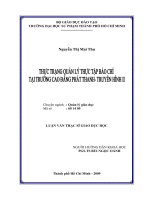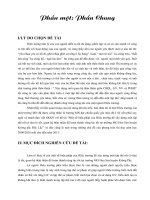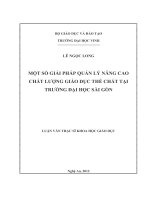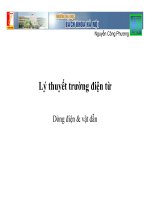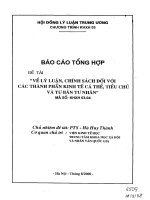Ly truong thanh que 4240 assignsubmission file 4a10 ly truong thanh que robert frosts poem the road not taken a cognitive linguistic approach
Bạn đang xem bản rút gọn của tài liệu. Xem và tải ngay bản đầy đủ của tài liệu tại đây (116.3 KB, 20 trang )
Running head: THE ROAD NOT TAKEN: A COGNITIVE LINGUISTIC APPROACH
1
ROBERT FROST’S POEM “THE ROAD NOT TAKEN”
A COGNITIVE LINGUISTIC APPROACH
Ly Truong Thanh Que
Class 4A
English Department
HCMC University of Pedagogy
Instructor: Nguyen Ngoc Vu, Ph.D
THE ROAD NOT TAKEN: A COGNITIVE LINGUISTIC APPROACH
2
30 December, 2013Abstract
English literary analysis is surely a field which attracts a great deal of attention from
both professionals and the literati as well. So as to study a literary work, we tend to
examine the literary devices, which calls for great efforts, since there is no fixed
underlying theory. Hence, Cognitive Linguistics, a relatively new branch of linguistics,
has offered another method to investigate the issue – a method provides us with Image
Schema and Conceptual Metaphor. Those are not merely dry concepts, but effective
ways enabling thorough investigation into the works. This linguistic view, nonetheless,
has not gained much recognition in the area of literature. Taking that matter into
consideration, this paper strives to scrutinize an analysis of a famous poem, “The Road
Not Taken” by Robert Frost, from a cognitive linguistic perspective; and hopefully, to
generate changes in attitudes towards the subject. Due to the finite scope, the paper will
be centered on only the Image Schemas and Conceptual Metaphor appearing in the
poem, concerning the fact that they are major aspects of Cognitive Linguistics.
Keywords: cognitive linguistics, image schema, conceptual metaphor, the road not
taken
THE ROAD NOT TAKEN: A COGNITIVE LINGUISTIC APPROACH
3
Introduction
Robert Frost (1874 – 1963) is considered as one of America and the world’s
greatest poets. His poems are known for depicting the rural life and conveying
convoluted social and philosophical themes through those depictions. “The Road Not
Taken”, published in 1916, is the epitome of his writing style:
“Two roads diverged in a yellow wood
And sorry I could not travel both
And be one traveler, long I stood
And looked down one as far as I could
To where it bent in the undergrowth;
Then took the other, as just as fair,
And having perhaps the better claim,
Because it was grassy and wanted wear;
Though as for that, the passing there
Had worn them really about the same,
And both that morning equally lay
In leaves no step had trodden black.
Oh, I kept the first for another day!
Yet knowing how way leads on to way,
I doubted if I should ever come back.
THE ROAD NOT TAKEN: A COGNITIVE LINGUISTIC APPROACH
4
I shall be telling this with a sigh
Somewhere ages and ages hence:
Two roads diverged in a wood, and I –
I took the one less traveled by,
And that has made all the difference.”
This poem is among the best-known, yet most-often-misunderstood works of
Robert Frost, perchance due to its last stanza: Readers and critics have their own ways
of deciphering the poet’s message.
Adopting a cognitive linguistic approach, this paper focuses on the Image
Schemas (PATH and BALANCE) and Conceptual Metaphor (LIFE IS A JOURNEY) of
the poem, and consequently offers some insight into the connotations hidden in Frost’s
words and writing style.
THE ROAD NOT TAKEN: A COGNITIVE LINGUISTIC APPROACH
5
Literature Review
Image Schema
Definition. Johnson (1987) defined an image schema as a recurring structure
within the cognitive process which functions like the abstract formation of an image,
thus joins together a wide range of experiences. “Experience” mentioned herein should
be understood in a broad sense, encompassing basic perceptual, social, linguistic,
historical (and so forth) experiences. Image schemas, therefore, are structures which
play an important role in organising our experience and comprehension.
For instance, Lakoff (1987) gave us the diagram of CONTAINER schema:
Interior
Boundary
Exterior
Figure 1. CONTAINER image schema
To be more specific, consider this example of two variants of CONTAINER
schema lexicalised by the word “out”:
Figure 2. John went out of the room.
Figure 3. The honey spread out.
THE ROAD NOT TAKEN: A COGNITIVE LINGUISTIC APPROACH
6
The image schemas in Figure 2 and Figure 3 are more detailed than the schema
in Figure 1, as they express motion as well as containment. This proves that specific
image schemas can be developed from fundamental ones.
The following is the list of image schemas discussed by both Johnson (1987) and
Lakoff (1987):
Table 1
Image schemas discussed by Johnson (1987) and Lakoff (1987)
No.
1
2
3
4
5
6
7
Image Schema
CONTAINMENT / CONTAINER
PATH / SOURCE – PATH – GOAL
LINK
PART – WHOLE
CENTER – PERIPHERY
BALANCE
FORCE
Image Schema in Literature. Cognitive linguists contend that some poets have,
consciously or unconsciously, utilized image schemas in their works.
For example, Freeman (2002) pointed out that Emily Dickinson used the
CONTAINER schema in her poem “Safe in their Alabaster Chambers”:
“Safe in their Alabaster Chambers Untouched by Morning and untouched by noon Sleep the meek members of the Resurrection,
Rafter of Satin and Roof of Stone –
THE ROAD NOT TAKEN: A COGNITIVE LINGUISTIC APPROACH
7
Grand go the Years,
In the Crescent above them Worlds scoop their Arcs and Firmaments - row Diadems - drop And Doges surrender Soundless as Dots,
On a Disk of Snow.”
The CONTAINER schema of death, in the first stanza, is “untouched” by time. By
contrast, in the second stanza, the years go by in the cyclical swing of planetary motion.
The terms “Crescent”, “Arcs” and “Disk” are also closely connected with CIRCLE and
CYCLE schemas, which are parts of the main CONTAINER schema.
Conceptual Metaphor
Definition. According to Lakoff and Johnson (2003), the essence of conceptual
metaphor is understanding and experiencing one idea, or conceptual domain, in terms
of another.
Conceptual metaphors exist in everyday language, as shown in the below
examples of the metaphor TIME IS MONEY:
(1)
(2)
(3)
(4)
(5)
You are wasting my time.
This gadget will save you hours.
How do you spend your time these days?
That flat tire cost me an hour.
Put aside some time for ping pong.
THE ROAD NOT TAKEN: A COGNITIVE LINGUISTIC APPROACH
8
In our contemporary world, time is a valuable and limited resource that we use to
achieve our goals. Thus we regard time as a thing that can be wasted, saved or spent,
like money: this leads to the presence of the metaphor TIME IS MONEY in our daily life.
As for the structure of conceptual metaphor, there are three main components:
Source, Target and Mapping. The Source domain is the conceptual domain from which
conceptual expressions can be drawn, while the Target domain is the one we try to
comprehend. Mapping is the systematic set of correspondences existing between the
constituents of the Source domain and those of the Target domain.
Lakoff (1993) gave the example of the Source, Target domains and Mappings in
the metaphor LOVE IS A JOURNEY:
Table 2
Source Domain, Target Domain and Mappings in the conceptual metaphor LOVE
IS A JOURNEY, suggested by Lakoff (1993)
Source Domain:
JOURNEY
travellers
vehicle
destination
Mappings
Target Domain:
LOVE
lovers
lovers’ relationship
lovers’ common goal
Conceptual Metaphor in Literature. The Linguistic Society of America claims
that one of the most recent approaches to literature is cognitive metaphor.
For instance, Lakoff and Turner (1989) applied conceptual metaphor in analysing
Shakespeare’s Sonnet 73:
“That time of year thou mayst in me behold
When yellow leaves, or none, or few, do hang
THE ROAD NOT TAKEN: A COGNITIVE LINGUISTIC APPROACH
9
Upon those boughs which shake against the cold,
Bare ruin'd choirs, where late the sweet birds sang.
In me thou seest the twilight of such day
As after sunset fadeth in the west,
Which by and by black night doth take away,
Death's second self, that seals up all in rest.
In me thou see'st the glowing of such fire
That on the ashes of his youth doth lie,
As the death-bed whereon it must expire
Consumed with that which it was nourish'd by.
This thou perceivest, which makes thy love more strong,
To love that well which thou must leave ere long.”
Their analysis indicated that in this sonnet, there are three metaphors for a
lifetime: a day, a year and a fire. Those metaphors come from the basic ones: Life is
Light and Death is Darkness; Life is Heat and Death is Cold; and A Lifetime is a Cycle of
Waxing and Waning. Days, years and fires are like waxing and waning cycles: the
waxing process involves light and heat, and the waning is with darkness and cold.
THE ROAD NOT TAKEN: A COGNITIVE LINGUISTIC APPROACH
10
Methodology
This paper zeroes in on a qualitative research examining the poem “The Road
Not Taken” by Robert Frost through the lens of Cognitive Linguistics.
I will analyse the poem by means of extensive reading, taking close notice of the
image schemas and conceptual metaphors used; those can be in the form of literary
devices, structures or ideas. I will also pay attention to other analyses of the poem,
synthesise the information and supplement my own analysis with them. Then I can draw
a conclusion from the collected data and my investigation, as well as trying to decode
the message conveyed.
Thanks to this methodology, the paper can provide a detailed analysis of the
poem, basing on both personal ideas and other critics’ opinions. Nevertheless, the
method also possesses a drawback. Since this paper contains my own points from a
cognitive linguistic view, it can be subjective, to a certain extent, in the understanding of
the poem’s image schemas and metaphors.
THE ROAD NOT TAKEN: A COGNITIVE LINGUISTIC APPROACH
11
Findings
Image Schemas
PATH. The PATH schema can be observed through the structure of the poem. It
has a starting point (when the speaker reaches the fork), a movement process – a
series of points along the way (the speaker’s thoughts and decision about the two
roads), and an ending point (the speaker has chosen one road and envisages the future
in which he may regret his decision).
BALANCE. The BALANCE schema exists in Robert Frost’s poetics. In “The
Road Not Taken”, the presence of this schema can be justified with the rhythm and
meter. The abaab rhythm is, at first, steady; then it is faster, reaching a climax in the
third stanza (Oh, I kept the first for another day!). It falls again in the final lines,
expressing the control exerted by the poet. This poem is written with iambic tetrameter
which helps keeping it under control. The ideas are also parts of the BALANCE schema.
After the climax in the third stanza, the poet put curbs on the dynamic flow of movement
in the past by creating an ending with envisioned future and the present (which is his
reality space).
Conceptual Metaphor
LIFE IS A JOURNEY. In this poem, the speaker’s perspective is moved from the
past (in the first three stanzas) to the future (the first two lines of the last stanza) and
then the present (the last line). That point, along with the theme of the poem (making
choice in life), verifies the existence of the metaphor LIFE IS A JOURNEY THROUGH
TIME. Besides, the symbols of the two roads, the traveller, his chosen or not chosen
THE ROAD NOT TAKEN: A COGNITIVE LINGUISTIC APPROACH
12
paths and his sigh also represent our life as a journey with decisions to be made and
regretted.
THE ROAD NOT TAKEN: A COGNITIVE LINGUISTIC APPROACH
13
Discussion
Image Schemas
PATH. In Robert Frost’s 1939 essay “The Figure a Poem Makes”, he expressed
his theory of poetry in a brief way: a poem (or the figure it makes) should begin with
delight, tend towards the impulse, assume direction with the first line, run a course of
events, and finally, end in a clarification of life. That “clarification of life” is not
necessarily a great one, “but in a momentary stay against confusion” (as cited in
Freeman, 2002, p. 2).
The aforementioned theory can be seen in “The Road Not Taken”. The calm
opening lines introduce the time when the speaker arrives at the fork in his trip:
“The roads diverged in a yellow wood
And sorry I could not travel both”
Then he ponders and makes the decision on which road to take:
“And be one traveler, long I stood
And looked down one as far as I could
To where it bent in the undergrowth;
Then took the other, as just as fair,
And having perhaps the better claim,
Because it was grassy and wanted wear;
Though as for that, the passing there
Had worn them really about the same,
THE ROAD NOT TAKEN: A COGNITIVE LINGUISTIC APPROACH
14
And both that morning equally lay
In leaves no step had trodden black.”
The speaker’s thoughts are spread over the lines, until the first complete
sentence of the poem ends with “In leaves no step had trodden black.”. They are the
“course of events” put along the path. The three last lines of the third stanza – also the
second sentence – engender the climax:
“Oh, I kept the first for another day!
Yet knowing how way leads on to way
I doubted if I should ever come back.”
Eventually, the poet put an end, “a momentary stay”, to the path with a
remorseful sigh:
“I shall be telling this with a sigh
Somewhere ages and ages hence:
Two roads diverged in a wood, and I,
I took the one less traveled by,
And that has made all the difference.”
To recapitulate, the internal structure of “The Road Not Taken” is clear with a
starting point, an array of elements and an ending point, which are, according to
Johnson (1987), the features of the linear PATH schema.
BALANCE. As I have mentioned in the Findings part, the BALANCE schema is
conveyed in the form of poetics. The poem can maintain the balance thanks to its
rhythm. The constant abaab rhythm pattern in the first lines becomes stronger and
stronger in the following ones, then fierce at the peak of movement:
THE ROAD NOT TAKEN: A COGNITIVE LINGUISTIC APPROACH
15
(6) Oh, I have kept the first for another day!
(a)
Yet knowing how way leads on to way
(a)
I doubted if I should ever come back.
(b)
However, the poet still put some control on this dynamic flow by making the
rhythm fall again in the last stanza.
“The Road Not Taken” is an iambic-tetrameter poem, which means that each line
has eight main syllables. There are four unstressed syllables, each of which is followed
by one stressed syllable:
(7) da DUM da DUM da DUM da DUM
X /
X /
X /
X /
(da (X): unstressed syllable, DUM (/): stressed syllable)
Let’s apply (7) to some lines in the poem:
(8) Though
X
as
/
for
X
that
/
(9) And
both
that
morning
/
X
X
/
(10) Because
it
was
X
X
/
/
the
X
X
grassy
X
passing
/ X
there
/
equally
lay
/ X
/
and
/
wanted
X
wear
/
(In (9) and (10), there are 9 or 10 syllables in a line, yet some syllables may be
elided, such as “ly” in “equally, “y” in “grassy”, and so on.)
THE ROAD NOT TAKEN: A COGNITIVE LINGUISTIC APPROACH
16
This type of meter helps control the poem, including the climax. The abovementioned perfect abaab rhythm also serves to stabilize this meter.
Another testament to the existence of BALANCE schema is the speaker’s
perspective: It changes from the past grounding in the first three stanzas to the future in
the first two lines of the last one:
“I shall be telling this with a sigh
Somewhere ages and ages hence:”
The poem ends with the present, which is the real state of the speaker:
“And that has made all the difference.”
Freeman (2002) regarded this appearance of the present as the poet’s way to
strike a balance between the past in which the speaker made the decision and the
future which may provoke the recalling of the past decision.
In a nutshell, all those characteristics are parts of the poem’s parallel BALANCE
schema, since they show the forces which balance off one another (Johnson, 1987,
p.80).
Conceptual Metaphor
LIFE IS A JOURNEY. The changing perspective is also an aspect of the
metaphor LIFE IS A JOURNEY THROUGH TIME. The past, the future and the present
co-exist in the poem, creating a frame of a lifetime.
“The Road Not Taken” tells a story about a traveller’s choice of path during his
journey, in which lies the philosophy of people’s decisions in their lives. The speaker’s
sigh in the envisaged future is interpreted, by most critics, as a regret. The poem’s main
theme, according to Eleanor Sickels, is about “the human tendency to wobble illogically
THE ROAD NOT TAKEN: A COGNITIVE LINGUISTIC APPROACH
17
in decision and later to assume that the decision was, after all, logical and enormously
important, but forever to tell of it 'with a sigh' as depriving the speaker of who-knowswhat interesting experience." (as cited in Finger, 1978, p. 479). Thus, the major
metaphor in this poem is LIFE IS A JOURNEY with decisions to be made and regretted.
Moreover, the symbolic images of the fork, the traveller and his sigh can be
analysed with the aid of Conceptual Metaphor:
Table 3
Source Domain, Target Domain and Mappings in the conceptual metaphor LIFE
IS A JOURNEY of the poem “The Road Not Taken” by Robert Frost
Source Domain:
JOURNEY
the traveller
the two roads
the road chosen
the road not chosen
the sigh
Mappings
Target Domain:
LIFE
a human being / human
race in general
the things from which
people have to choose one
the thing chosen / our final
decision
the thing not chosen / the
thing making us regret in
the future
our regret in the envisioned
future
In conclusion, the conceptual metaphor LIFE IS A JOURNEY is depicted in the
poem “The Road Not Taken” through its theme, symbols and the speaker’s changing
perspective.
THE ROAD NOT TAKEN: A COGNITIVE LINGUISTIC APPROACH
18
Implications
“The Road Not Taken” by Robert Frost is a tricky poem which causes a lot of
confusion among its readers and critics. With a view to unearthing the meaning of this
poem, this analysis tries to point out the Image Schemas and Conceptual Metaphor the
poet might have used. Through these new spectacles, I believe that the poem is about
the choices people have to make in their lives and the way they may reflect on those
decisions later. Another message is about how human beings tend to regret their own
choice even when they think that decision is not wrong, since they wonder what they
could have experienced if they had chosen differently.
In addition, this analysis demonstrates a new way of examining literary works,
using the cognitive linguistic approach. Literature analysing is a challenging task, even
to professionals, as it requires in-depth studies. Hence, analysts usually adopts many
measures in order to perceive the whole picture of the works, and one of those
methods, as proved in this paper, can be Cognitive Linguistics. Image Schema,
Conceptual Metaphor and other facets of this linguistic view may make a great
contribution to our exploration of the world’s literary masterpieces.
THE ROAD NOT TAKEN: A COGNITIVE LINGUISTIC APPROACH
19
Conclusion
Regarding the analysis of the poem “The Road Not Taken” by Robert Frost
above, this paper accentuates the Image Schemas and Conceptual Metaphor utilised
by the poet, which aids in determining the latent purport of his work. Moreover, it
pinpoints the feasibility of the application of Cognitive Linguistics to literature analysing.
Hopefully, the paper can also assist the process of drawing attention to this issue in
literary areas.
THE ROAD NOT TAKEN: A COGNITIVE LINGUISTIC APPROACH
20
References
Finger, L. L. (1978). Frost’s “The Road Not Taken”: A 1925 Letter Come To Light.
American Literature, 50(3), 478-479.
Freeman, M. H. (2002). Momentary Stays, Exploding Forces: a Cognitive Linguistic
Approach to the Poetics of Emily Dickinson and Robert Frost. Journal of English
Linguistics, 30(1), 73-90.
Johnson, M. (1987). The Body in the Mind: The Bodily Basis of Meaning, Imagination,
and Reason. Chicago, IL: University of Chicago Press.
Lakoff, G. (1987). Women, Fire and Dangerous Things. Chicago, IL: University of
Chicago Press.
Lakoff, G. (1993). Conceptual Metaphor: The Contemporary Theory of Metaphor. In D.
Geeraerts (Ed.), Cognitive Linguistics: Basic Readings (pp.188-213). Berlin:
Mouton de Gruyter.
Lakoff, G., & Johnson, M. (2003). Metaphors we live by (2nd ed.). Chicago, IL: University
of Chicago Press.
Lakoff, G., & Turner, M. (1989). More than Cool Reason: A Field Guide to Poetic
Metaphor. Chicago, IL: University of Chicago Press.

